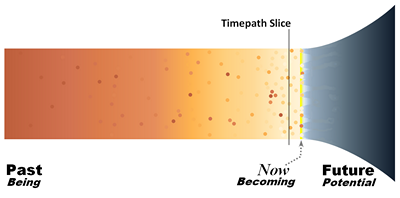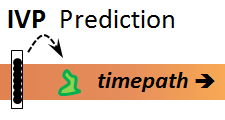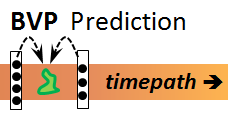How can we know that this Which caused that What? It depends on how we use the timepath.
We continue where we stopped our discussion in Time Path – The Flow of Time. and discuss how we identify what happened in the past. The timepath visualization of Fig 1 helps us understand the past. (Click any figure for full resolution.)
Our timepath is formed out of the the Past (the unchanging record of events that have occurred) the Now (where possible actions are actualized to the events that form reality), and the Future (the open possibilities for potential actions that could become realized in the Now).
The horizontal direction ( ← ) is time direction leading from the Now, when such things started, into the Past. A vertical slice ( | ) separates the timepath into left and right regions. The perfectly thin slice is an instantaneous 3 dimensional image of the entire universe. The moment Now is an example of such a slice.
We start with a quick summary of what the timepath means, then examine how use slices and look at our Past to discover activity patterns. We will reach 3 conclusions:
- A timepath slice should be an instantaneous view of the universe, but – because every event loses contrast as it moves deeper into the fog of the past – the width along the timepath must increase as we move into the deeper past. Such a 3D separator marks an interval about a specific time in the past so we can label events as before and after. Our choice of a boundary will effect our judgement of cause and effect.
- We cannot identify every last thing that happened on any chosen boundary, so differences in interpretations are inevitable.
- Since Now is the beginning of the timepath, it is NOT a “boundary” – it does not divide realized events into before and after. Now is one-sided, having only the entire Past before.
Summary Of Our Previous Discussion
Fig 2 is the timepath, showing a few of the events forming at the Now; new events push the just-formed ones into the static record. The key regions are Future, Now, and Past.
- Future In advance of the happenings of Now, there is the swirl of formless potential actions, each with an associate probability of becoming real. It makes no sense to discuss time durations such as minutes or hours because there are no realized structures or events for a clock to work with.
- Now The associated probabilities continuously morph into certainty or evaporate to zero as all potential events coalesce into the becoming of actualized events that are happening. Our awareness is focused about what we experience as Now.
- Past After Now, what did happen has happened. There are no probabilities for new events materializing into the past record. There is just the past, as a record of events that happened.
The fully realized events are colorized to show that events lose contrast and fade from view as they recede into the increasingly murky background of the past. Events fade, but do not go away, because each that becomes realized is part of the continuum of all real events, important when they happened but no longer visible in the record. Even seemingly trivial events (leaving no discernible record) participate in the web of causal connections we call reality.
The Problem with Boundaries
Suppose you want to study the giant meteor impact event 60M years BN (before Now) and decide to use an instantaneous timepath slice at 59,151,122 years 3 months, 2 days, 11 hours and 22 seconds. If you ignore all data that are not at this time slice, your data set would be non-existent or at least sparse!
To get sufficient data to support a conclusion, you would have to give up instantaneous slices and use boundaries that have a time interval. This has a major impact on our studies of the causal event paths that have occurred in the past.
Fig 3 shows timepath boundaries in more detail. Because events become increasingly harder to identify the farther you go into the past, the boundaries must become increasingly wider.

Fig 3 Time path boundaries require wider intervals (thicker lines) the farther one goes into the past.
There are two standard but different ways to determine what actually happened. We can view that question as either an Initial Value Problem, or a Boundary Value Problem. , techniques studied in detail since Isaac Newton’s time.
Initial Value Problem (IVP)
See Fig 4. If we could know both…
- all details of what is happening at any instant in the past
- the natural laws that truly govern activities
we could predict with extreme accuracy what happens a bit later, closer to Now.
But a timepath boundary is the entire 3D universe – and this is the issue.
Perfect IVP solutions need simultaneous knowledge of absolutely everything.
Our Box points out – accurate solutions of an IVP problem require all the data from any situation that might affect the outcome of our study.
Question: How far out should we go?
Answer: How isolated is your problem?
When can you stop expanding the data region? After all, “It is eagles all the way out!”
Physicists study well-isolated systems and are very successful using IVP techniques. But success is due to the isolation from the rest of the universe. Note that “But” sentence.
IVP bottom line – Avoid IVP solution techniques unless that is all you have. Except for ideal cases, IVP results must have low expected accuracies.
Boundary Value Problem (BVP)
Slice out two boundaries across the time path as before; then get as much information as you can on both. Although the IVP issue means your understanding about the initial values (earliest boundary) are only approximate, you also know how the process turned out at later time, allowing you to do the equivalent of adjusting for IVP errors.
Think of medical CAT scans (the patient’s immobility approximates instantaneous) Tomography puts an x-ray source on a surface around the object (3D boundary) and measures the x-ray intensity on the other side after the beam passed through the bounded volume. You can get a pretty good 3D image of what is inside just by knowing only what happened around the boundary. MRIs work the same sort of way.
BVP estimates can be pretty good even when all the details are not fully known. Although there are some problems that even BVPs cannot solve, boundary value solutions using separators before and after what is being studied are the most reliable way to examine historical paths.
Boundaries can be too broad To get more usable data as a study moves into the distant past, the boundary interval must expand, but how can you know the data are independent information and that one does not cause another? Fig 6 shows an example of 2 boundaries that overlap. One is so big that dividing into the 2 needed for a BVP is not reasonable.
The Chicxulub meteor hit the Gulf of Mexico about 60 Million years ago; dinosaur bones stopped being produced about then. Meteor effects are accurately dated, but the dinosaur boundary is wide.
Did the monster meteor kill the dinosaurs? This is still being argued. A BVP timepath boundary 1% of the time since impact would be 600,000 years long.
North American passenger pigeons became extinct in just a few short years, meaning that short extinctions can be common. With a Chicxulub event, animals larger than 50 kg might well have died out in a few months. That long ago, it is hard to prove causation beyond a reasonable doubt.
BVP studies can fail synchronicity and completeness. The boundary value issues affects historical understanding. In Fig 3, boundaries are thick, meaning boundary data might not be concurrent. Event dots fading into the foggy past indicate data will be sparse, and will not provide the complete set of everything that happened on the boundary. Some teachers say that because of synchronicity and completeness problems, the past is an illusion. Well, no, they just make life more interesting.
The Timepath Now Is Not A “Boundary”
Recall that a zero thickness vertical slice across the timepath indicates an instantaneous image of the entire 3D universe. And that all boundary divides the timepath into before (to the left of the Fig 1 slice) and after (to the right of the Fig 1 slice).
Now can not be a “boundary” because all of before stretches to the left of Now, but there is no realized after.
Events cannot exist in our reality until the probability distributions that represent possible actions become certain and actualize or vanish. Realization of events happens in the Now, where our awareness must reside.
During the Now of 2008, politicians thundered that helping those who lost their jobs would destroy what remained of the economy. They were applying initial value problem techniques to form their projections.
Because the slice they used was at Now, the burning edge of the timepath, they could not know every detailed event of that slice as they were assembling. They could not have used BVP techniques because they could not (A) construct a boundary in the future or (B) transmit any information back to themselves. So the old Pols had no way to make IVP projections that were even close to accurate. They used ideology to substitute for data and were just plain wrong. The commonly-held empathic gut feeling was right. We should have helped those in dire need of a boost.
We pointed this out in a different way in Ideologies Can’t Work.
Boundaries, Predictions and All That
We have been discussing the Time Path, a visualization/conceptualization of the structure of time. It is not a scientific model because there is no formal math structure that we can use for predictions. It is certainly not a “theory” because no new prediction have proven accurate through testing. As this is written, no physicist has succeed in building any successful theory of time – but we are still trying.
This is the 2nd post in the Time Path Ontology chain, and to 6th explore the timepath.
……………………………….
Charles J. Armentrout, Ann Arbor
2015 July 29
Listed under General… a post in the thread General > Time Path
Have a comment? Click on the title of this post, go to bottom, let us know.
Related posts: Click the INDEX menu under the Banner picture







